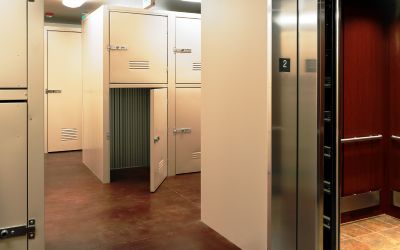Designing a Successful Wine-Storage Area in Self-Storage Facilities
Wine-storage customers want the same basic services as self-storage customers: easy access, clean and safe facilities, and reasonable prices. But they also want the comfort of knowing the facility operator has correctly completed the climate-control aspects of the wine-storage area, and emergency operating plans and security are in place. In short, successful wine storage begins with the right design.
August 16, 2011

By Jost Lunstroth
The needs and desires of someone seeking to store their valued wine collection at a self-storage facility are very different from those of someone looking for traditional self-storage space. Wine collectors can be young or old, wealthy or struggling to pay their bills, or own hundreds and hundreds of cases or just a few more than they can properly store at home. Even with all these differences, wine connoisseurs share an invisible bond: a love of wine and the awareness that it must be properly stored.
Wine collectors want the same basic services as the self-storage customereasy access, clean and safe facilities, and reasonable prices. But they also want comfort, the comfort that comes from knowing their precious collection is protected from thieves and fluctuating temperatures. They get this comfort from knowing the facility operator has correctly completed the technical aspects of the wine-storage area, and emergency operating plans and security are in place. Im not talking about a fancy door or a painting of Tuscany on the wall. Successful wine storage begins with the right design.
Maintaining Climate
The technical aspect of wine storage is pretty straightforward but not trivial to properly execute. The most critical component is maintaining the correct climate, including temperature and humidity. The generally accepted climate for proper wine storage is 55 degrees and around 60 percent relative humidity. The difficulty of maintaining this climate can vary from one region to anotherwhat works in a cold region like Michigan might not work in hot and dry Arizona or hot and humid Louisianabut the core challenges are the same.
One challenge is selecting and installing refrigeration equipment that can maintain the desired climate. Another is building a space that can separate the two climatesthat of the wine-storage area and then the surrounding areas.
Traditional refrigeration may not always be the best equipment to use for one major reason: Standard refrigeration equipment usually removes humidity as part of the cooling process, so you run the risk of having a space with the correct temperature but low humidity. A humidifier may be required to add humidity back into the space.
Refrigeration equipment designed specifically for wine storage is available, and most wine-storage builders recommend it. It may cost more up front, but it will save you time and headaches in the long run. This equipment is designed to cool the space in a way that doesnt remove humidity.
Wine collectors also want to be assured you can maintain the proper climate even if theres an equipment failure. Your wine-storage area must have a redundant system for emergencies or outages. Customers will be comforted when you describe the backup refrigeration system to them. It shows you truly understand the need to protect their prized wine collections.
Preventing Moisture
Once youve designed the ideal refrigeration system, the next step is building the space to avoid moisture-related problems. A wine-storage area is just like your home refrigerator; it will have a different climate than the surrounding area, and the two climates cannot meet.
If your refrigerator door is left open just a bit, condensation develops on the items inside. If the door is left wide open, the refrigerator motor will burn out since it never turns off. You dont want moisture on your wine-room walls, so make sure your space is sealed tight.
Fail-Safes and Security
Once you have a wine room thats properly built so theres no condensation, the refrigeration system maintains the correct climate, and theres redundancy in the refrigeration system, is that enough to get wine collectors to pay a premium for your product? There are two more important components to wine storage that will help turn prospects into clients and clients into referrers. One is a solid emergency preparedness plan, the other is extra security.
Wine collectors live in constant fear that a power failure will ruin their collection. Allay that anxiety with a well-devised plan for emergencies, and tell customers how the system works.
Wine collectors also want to know their collections are safe and private. You can ensure this by adding security on the access doors to the wine-storage area, as well as locks and solid walls and doors on each individual locker.
Following these recommendations will not guarantee that wine collectors will beat your door down and pay a premium for space, but doing so greatly improves your chances by increasing the value of the wine storage your facility provides.
Jost Lunstroth is president of Nos Caves Inc. He developed and operates Nos Caves Vin, a premium off-site wine-storage facility in Houston, and consults on wine storage through NCV Wine Management, a consultancy focused on wine collections. For more information, visit www.ncvwinemanagement.com.
You May Also Like





